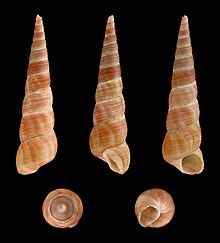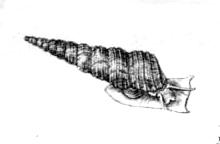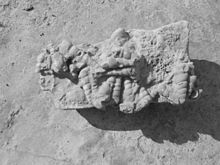
Turritella is a genus of medium-sized sea snails with an operculum, marine gastropod mollusks in the family Turritellidae.

The Trochidae, common name top-snails or top-shells, are a family of various sized sea snails, marine gastropod molluscs in the subclass Vetigastropoda. This family is commonly known as the top-snails because in many species the shell resembles a toy spinning top.

Fissurellidae, common name the keyhole limpets and slit limpets, is a taxonomic family of small to medium-sized limpet-like sea snails, marine gastropod molluscs in the clade Vetigastropoda.

The gastropod shell is part of the body of a gastropod or snail, a kind of mollusc. The shell is an exoskeleton, which protects from predators, mechanical damage, and dehydration, but also serves for muscle attachment and calcium storage. Some gastropods appear shell-less (slugs) but may have a remnant within the mantle, or in some cases the shell is reduced such that the body cannot be retracted within it (semi-slug). Some snails also possess an operculum that seals the opening of the shell, known as the aperture, which provides further protection. The study of mollusc shells is known as conchology. The biological study of gastropods, and other molluscs in general, is malacology. Shell morphology terms vary by species group.

A land snail is any of the numerous species of snail that live on land, as opposed to the sea snails and freshwater snails. Land snail is the common name for terrestrial gastropod mollusks that have shells. However, it is not always easy to say which species are terrestrial, because some are more or less amphibious between land and fresh water, and others are relatively amphibious between land and salt water.

Turritellidae, with the common name "tower shells" or "tower snails", is a taxonomic family of small- to medium-sized sea snails, marine gastropod molluscs in the Sorbeoconcha clade.
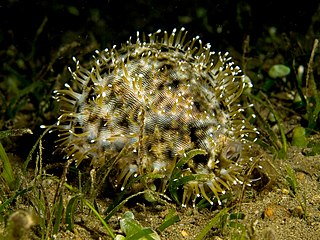
Cypraea tigris, commonly known as the tiger cowrie, is a species of cowry, a large sea snail, a marine gastropod mollusk in the family Cypraeidae, the cowries.

Neverita lewisii, common name Lewis's moon snail, is a species of large operculated sea snail. It is a predatory marine gastropod in the family Naticidae, the moon snails. Traditionally, this species was assigned to either the genus Lunatia, the genus Polinices or the genus Euspira. Recently, it was assigned to the genus Neverita based on molecular data.

Euspira catena, previously known as Natica catena, common name the large necklace shell, is a medium-sized species of predatory sea snail, a marine gastropod mollusc in the family Naticidae, the moon snails.
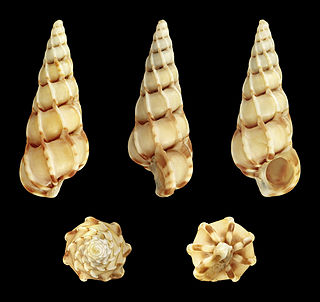
Epitonium clathrus, also known as the common wentletrap, is a species of small predatory sea snail, a marine gastropod mollusc in the family Epitoniidae, the wentletraps.
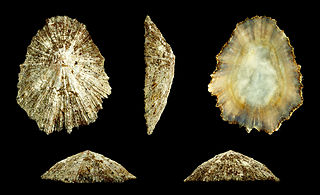
Patella aspera is a species of limpet, a type of sea snail in the family Patellidae. Long considered to be a subspecies of Patella ulyssiponensis, genetic evidence supports its recognition as a separate species. It is native to Macaronesia. It is known by the common name Azorean limpet, and its local name is lapa brava.

Choristella tenera is a species of sea snail, a marine gastropod mollusk in the family Choristellidae.
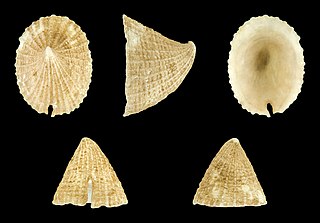
Emarginula fissura, the common slit limpet, is a species of sea snail, a marine gastropod mollusk in the family Fissurellidae, the keyhole limpets.

Agaronia testacea, a species of sea snail with the common name Panama false olive, is a marine gastropod mollusk in the family Olividae, which are known collectively as "the olives".

Turritella cingulifera is a species of sea snail, a marine gastropod mollusk in the family Turritellidae.
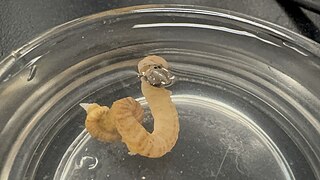
Vermicularia knorrii, commonly known as the Florida worm snail, is a species of sea snail, a marine gastropod in the family Turritellidae. V. knorrii has been concluded to be the junior synonym to Vermicularia lumbricalis. The shell of Florida worm snail is light brown or tan in color with an apex that is white. It is found living in reefs on the coasts of the southern states of the United States to the top of South America. V. knorri use their ciliated appendages to trap plankton and sperm.
Crepidula ustulatulina is a species of small sea snail, a slipper snail, a marine gastropod mollusk in the family Calyptraeidae, the slipper snails or slipper limpets, cup-and-saucer snails, and Chinese hat snails.

Arrhoges occidentalis, common name the American pelicanfoot, is a species of medium-sized sea snail, a marine gastropod mollusk in the family Aporrhaidae, the pelican's foot snails or pelican's foot shells.

Stellaria chinensis is a species of large sea snail, a marine gastropod mollusk in the family Xenophoridae, the carrier shells.

Lutraria lutraria is a species of large marine bivalve mollusc in the family Mactridae. Its common names include the otter shell and the common otter shell. It occurs in coastal regions of the north east Atlantic Ocean where it lives buried in the sand.
